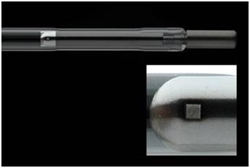Heraeus Ignite Technology for reliable lamps

Trigger spots in arc- and flash lamps make ignition processes more reliable. Copyright Heraeus Noblelight 2010<br>
Arc and Flash lamps are used for a variety of different applications. For precise measure of distance in laser based range finders, for laser excitation in industry also for aesthetic and sun simulation applications. These lamps must work reliably and the ignition process should be constant and repeatable.
The development of Heraeus Ignite Technology (HIT™) embodies Arc and Flash lamps of Heraeus Noblelight, which have a trigger spot. Through a new specific developed manufacturing step the electrode material will be vacuum metalized in a certain form and on a fixed place in the lamp. This reduces the Ignition voltage and makes the Ignition process more reliable.
Tests show a reduction of the trigger voltage of more than 60% and an increase in the efficiency of an existing system.
Hair removal and skin treatment with pulsed light are a growth market. Flash lamps, which are the main light source of pulse light devices, must have an outstanding quality so that a safe and effective treatment is possible.
The ignition properties of Arc and Flash lamps can be inconsistent, because the activation process is very complex and demands a priming or a start ionisation in the lamp gas (e.g. Xenon or Krypton).
It has been shown in prior art that by sputtering part of the electrode material on to the surface of the quartz near to the electrode, the voltage to ignite a lamp can be significantly lowered. The negative aspects of the prior art are that there can be a reduction in lifetime due to excessive sputtered material both artificially aging electrodes and blocking light transmission from the plasma.
Heraeus Ignite Technology HIT™
Heraeus Noblelight Ltd, Cambridge, developed a process to sputter some of the electrode material to improve the Ignition process without affecting lamp lifetime.
Through laser processing a defined amount and shape of evaporated material is created on the quartz inner surface. This has minimal effect on the optical properties of the quartz material and thereby lamp lifetime is not compromised.
The process significantly reduces the ignition voltage; initial results show an average trigger voltage reduction of more than 60%.
Furthermore the ignition process is more reliable and more constant. This is very important, where power supply and system may be limited. It may be possible to utilize a more powerful lamp to be used without replacing the pulse generator, allowing the operator to use his available equipment and potentially increase his efficiency clear.
Heraeus Noblelight Ltd. in Cambridge develops and produces continuous arc and Flash lamps. Xenon/Krypton specialty lighting sources are successfully used in many laser and non-laser applications such as drilling, welding, cutting, marking, engraving, medical and aesthetic applications as well as sun-simulation.
All lamps are 100% tested to ensure expensive down time is avoided.
Heraeus, the precious metals and technology group headquartered in Hanau, Germany, is a global, private company with over 155 years of tradition. Our businesses include precious metals, sensors, biomaterials and medical products, dental products, quartz glass, and specialty light sources. With product revenues of € 2.6 billion and precious metal trading revenues of € 13.6 billion, as well as more than 12,300 employees in over 110 subsidiaries worldwide, Heraeus holds a leading position in its global markets.
Heraeus Noblelight GmbH with its headquarters in Hanau and with subsidiaries in the USA, Great Britain, France, China, Australia and Puerto Rico, is one of the technology and market leaders in the production of specialty light sources. In 2009, Heraeus Noblelight had an annual turnover of 71.6 Million € and employed 707 people worldwide. The organisation develops, manufactures and markets infrared and ultraviolet emitters for applications in industrial manufacture, environmental protection, medicine and cosmetics, research, development and analytical laboratories.
For further information please contact:
Reader questions:
Heraeus Noblelight Ltd.
Cambridge Science Park
Cambridge CB4 0FQ
Phone +44 1223 423324, Fax +44 1223 423999
E-Mail hnl-laserlamps@heraeus.com
Editor:
Dr. Marie-Luise Bopp
Heraeus Noblelight GmbH,
Department Marketing/Advertising
Phone +49 6181/35-8547, Fax +49 6181/35-16 8547
E-Mail marie-luise.bopp@heraeus.com
Media Contact
More Information:
http://www.heraeus-noblelight.comAll latest news from the category: Power and Electrical Engineering
This topic covers issues related to energy generation, conversion, transportation and consumption and how the industry is addressing the challenge of energy efficiency in general.
innovations-report provides in-depth and informative reports and articles on subjects ranging from wind energy, fuel cell technology, solar energy, geothermal energy, petroleum, gas, nuclear engineering, alternative energy and energy efficiency to fusion, hydrogen and superconductor technologies.
Newest articles

Silicon Carbide Innovation Alliance to drive industrial-scale semiconductor work
Known for its ability to withstand extreme environments and high voltages, silicon carbide (SiC) is a semiconducting material made up of silicon and carbon atoms arranged into crystals that is…

New SPECT/CT technique shows impressive biomarker identification
…offers increased access for prostate cancer patients. A novel SPECT/CT acquisition method can accurately detect radiopharmaceutical biodistribution in a convenient manner for prostate cancer patients, opening the door for more…

How 3D printers can give robots a soft touch
Soft skin coverings and touch sensors have emerged as a promising feature for robots that are both safer and more intuitive for human interaction, but they are expensive and difficult…





















